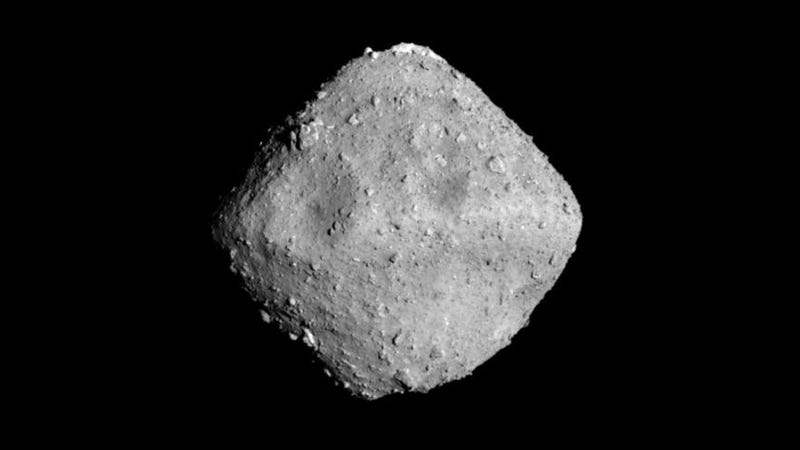 An incredible shot of the Ryugu asteroid, taken on June 26 by the Hayabusa2 probe. Image: JAXA, University of Tokyo and collaborators
An incredible shot of the Ryugu asteroid, taken on June 26 by the Hayabusa2 probe. Image: JAXA, University of Tokyo and collaborators
After nearly four years of traveling through space, the Hayabusa2 spacecraft has successfully rendezvoused with the Ryugu asteroid, the Japan Aerospace Exploration Agency confirmed Wednesday. Let the next stage of this historic sampling-and-return mission begin!
Earlier today, mission controllers at JAXA triggered Hayabusa2’s chemical propulsion thrusters, bringing the spacecraft into orbit around Ryugu, an asteroid that’s just shy of one kilometer (0.6 miles) wide. Confirmation of the rendezvous was made at 9:35 am Japan Standard Time (JST). JAXA says Hayabusa2's thrusters worked normally, and that the spacecraft is maintaining a constant distance from Ryugu.
“From this point, we are planning to conduct exploratory activities in the vicinity of the asteroid, including scientific observation of asteroid Ryugu and surveying the asteroid for sample collection,” explained JAXA in a press release.
The 1,300 pound Hayabusa2 probe, launched on December 3, 2014, is now about 180 million miles (290 million km) from Earth. The probe will survey Ryugu for the next 18 months, during which time its sampling device will collect bits of dust and rock from the asteroid’s surface. It will also dispatch four small probes onto the asteroid’s surface. Hayabusa2 will head back home in December 2019, arriving at Earth with its precious samples a year later.
The Ryugu asteroid has progressively come into focus over the past several days, revealing a shape akin to a diamond or a spinning top (or for you D&D fans out there, an eight-sided die). It’s bulging at the equator, and craters are clearly visible, as are chunks of large rocks. Ryugu is spinning very slowly, about once every 7.5 hours, which is good news for the mission. For JAXA mission planners, the challenge now is to figure out the best spot for Hayabusa2 to shoot its sampling device—a copper “impactor”—into the asteroid.
Artist’s concept of the Hayabusa2 probe taking an asteroid sample. Illustration: JAXA
“We have an impactor which will create a small crater on the surface of Ryugu,” Makoto Yoshikawa, Hayabusa2's mission manager, told the BBC. “Maybe in spring next year, we will try to make a crater… then our spacecraft will try to reach into the crater to get the subsurface material.”
By studying the bits and pieces that make up Ryugu, scientists are hoping to gain some important insights into the composition of the early Solar System and the conditions that gave rise to life on Earth. Asteroids are ancient objects, often containing traces of water and organic (or carbon-rich) materials.
But that’s for a later day. For now, let’s celebrate today’s very important milestone.
[JAXA, BBC]